Rome, city of contrast, its buildings from the ancient,
modern, renaissance, and baroque all meld into one maze of streets and
people. I was so excited to finally be
in Rome after spending so many days bouncing around
Italy. We got in early and after dropping our bags
at our hotel near the train station we hopped on the subway en route to have
lunch at the Spanish Steps, a glorious staircase on which many a romantic movie
has been filmed. I dreamed of getting
some takeaway lunch from nearby and lounging while eating pasta and drinking
wine on the steps. With this scene in my
mind we emerged from the metro station to see the steps covered in a giant
tarp, with restoration evidently ongoing.
Then it started to rain.
 |
So excited to be in the all famous coliseum in Rome!
|
Fortunately the pasta takeaway restaurant I had picked out
for us was nearby, and we ducked inside to grab lunch. Typical of Italian fast food, there were a
couple of options of pasta and sauce (linguini with mushroom sauce or gnocchi
with tomato sauce). Four euro gets you a
plate (or takeaway box) of your pasta choice and water that can be filled from
one of the water bottles around the standing-room-only restaurant. Usually these types of restaurants have more
customers taking away their lunch to eat on a bench or the rim of a fountain
somewhere than rather than in the restaurant.
Since it was raining outside there was more eating in than taking out,
and we were left standing shoulder to shoulder as we forked homemade pasta into
our gullets. I felt like I was getting
an authentic experience. David just
looked miserable.
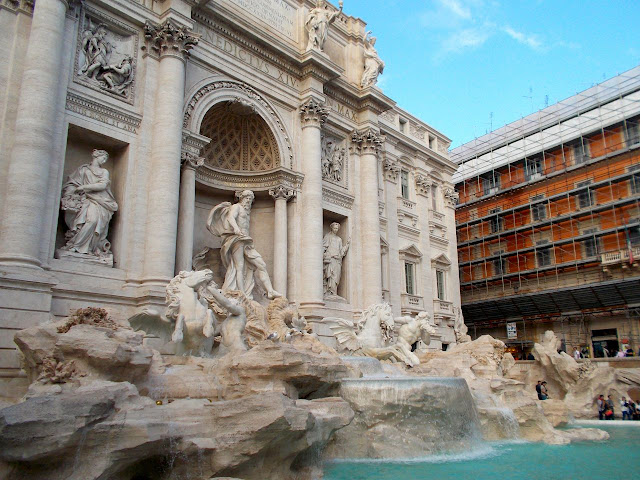 |
| The newly renovated Trevi Fountain built in the Baroque period. |
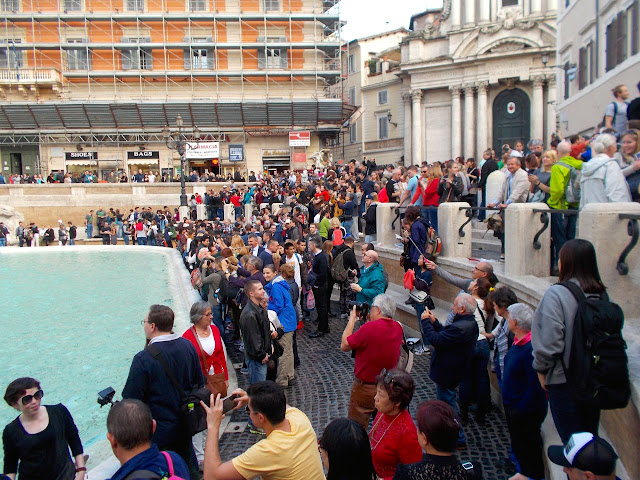 |
| The crowds of tourists excited to see the Trevi fountain in the off season. David poses with an old lady who wanted a photo with him while her husband snaps the shot. |
Fortunately the rain lightened enough when we finished our
lunch to allow us to walk outside without getting drenched. We stuck to the eaves as we made our way to
the Trevi Fountain, and by the time we arrived the rain had stopped
altogether. The Trevi Fountain was made
in the Baroque period (that’s post Renaissance and pre Modern) when all art
seemed to take on a light an airy feeling.
The fountain, newly restored and having re-opened one day prior was an
impressive sight. Each of its figures
were beyond life-like, more angelic than human.
We threw some coins in for luck and took a few photos. A couple who did not speak English asked
David to take their photos, which I guess he did so well, the wife wanted a
photo with David, which he patiently posed for.
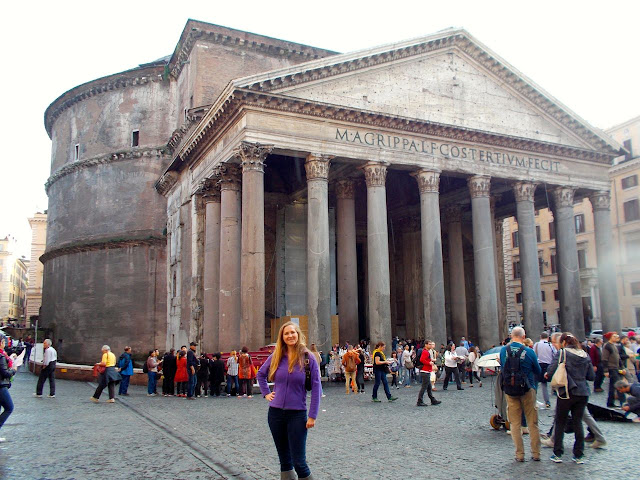 |
| I pose in front the Pantheon and its famous dome and columns. |
After the Trevi Fountain we went in search of the Pantheon a
few blocks away. The Pantheon is an
engineering marvel, as the fist large building with a domed ceiling. The architects achieved this feat by creating
recesses in the ceiling and leaving the most vulnerable part of the ceiling,
the summit, open. The oculus, as it is
now called is just large enough to allow in enough light to fill the Pantheon
without need of artificial light. Pantheon
means "all gods" and some believe it was a center of worship for anyone to worship all known gods. This is a matter of dispute however. Today it is a Christian church, with relics and statues adorning the circumference of the interior.
 |
| Inside the Pantheon the dome was an engineering marvel of the time. The oculus (hole) at its summit is the only light source. |
Yet again only a few blocks from the Pantheon was the Piazza
Navona; famous sites are only a stone’s throw away from each other in
Rome. In high school taking Latin ( I
later switched to Spanish since I thought it more useful) I spent some time once starring at a map of
ancient Rome. Aside from the famous
Coliseum there was another super structure in ancient Rome which housed tens of
thousands of citizens for viewing games of sport, mostly races. It was a long elliptical shaped stadium
called the Circus Maximus.
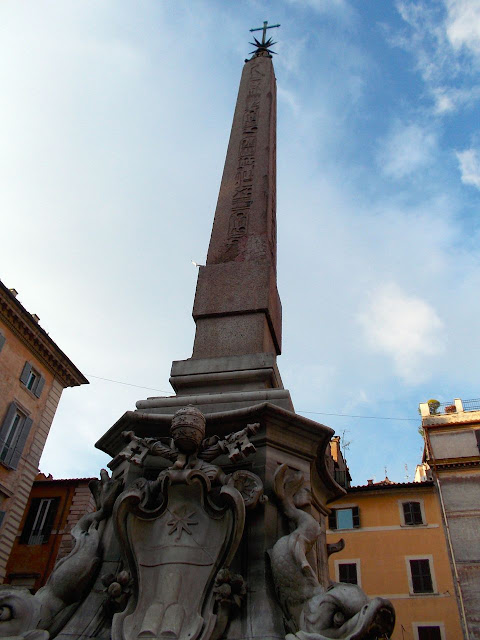 |
| An Egyptian Obelisk in the Piazza Navona, once home of the Circus Maximus. |
The Circus Maximus is no longer standing, but the shape of
it remains in the Piazza Navona, a pedestrian plaza built on what was the floor
of the stadium. Erected in the center of
the Piazza is another obelisk stolen from Egypt that once stood in the Circus
Maximus, just like the Obelisk in Saint Peter’s Square of
Vatican City was
taken from Egypt to decorate the center of a stadium there.
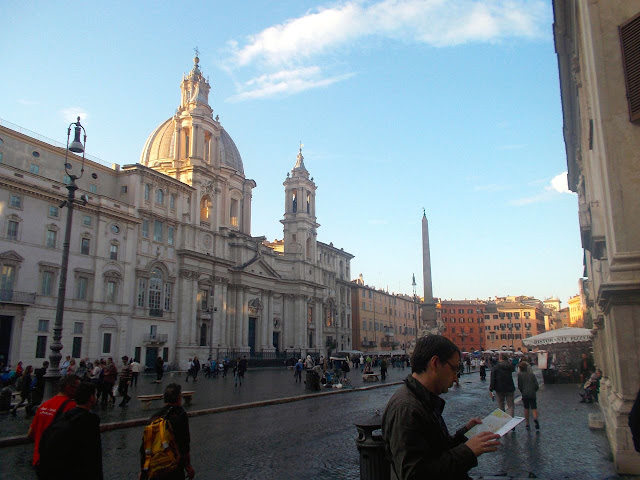 |
| The Piazza Navona after a light rain shower. The dome is a catholic church. |
The piazza was filled with people bustling about in and out
of the church adjacent and shopping for paintings amongst the stalls, despite
the wet weather. We took a lap around
the plaza admiring the fountains before exiting in search of our hotel.
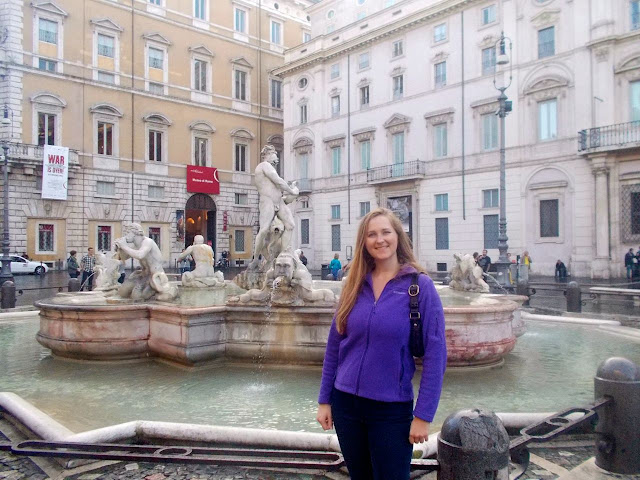 |
| Baroque era fountains can be found all over Rome. This on is in the Piazza Navona. |
We didn’t quite make a bee line for the hotel as David
wanted to check out the Time Elevator tourist trap. The Time Elevator is like so many other motion
simulator rides paired with a movie, that seem to be popping up in famous cities
world wide. I’ve seen similar
attractions in
Vancouver,
London, and Edinburg, although this was the first of
this type of attraction I have visited.
The Time Elevator took us on a journey through time to show us the
history of Rome. While it was fun in a
campy kind of way, none of the history was new to me making it somewhat of a
let down.
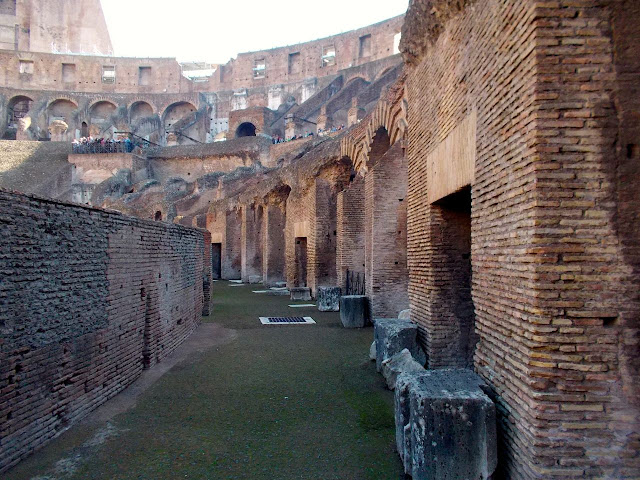 |
| An area of the coliseum not open to the general public. It's easy to see how the stands sections are organized. |
Our second day in Rome was spent in
Vatican City, which I’ve
already spent an entire post talking about.
So I am going to move on to our third, and my most anticipated day in
Italy the Coliseum and Roman Forum. We
visited the Coliseum on the weekend, and while it wasn’t dead, it was not
without a line either. I was a little
worried walking up to the gargantuan structure as tour guides outside were
trying to sell skip-the-line tickets for a surcharge claiming their was an hour
wait past security for the ticket line.
In reality we waited just over fifteen minutes all of which we were
already standing within the Coliseum, allowing us to take in the monument before
even buying our tickets.
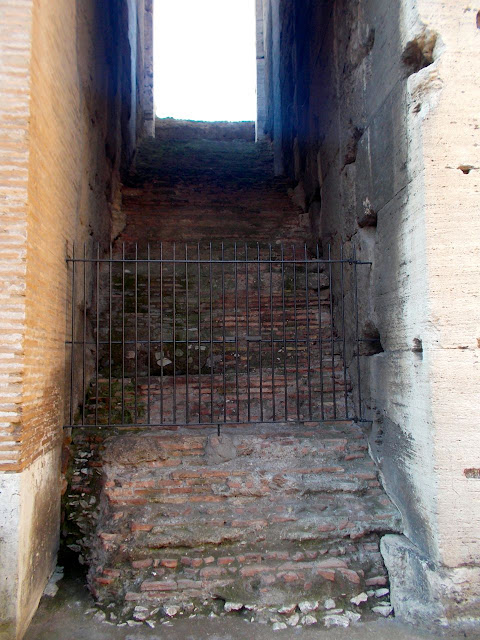 |
| A stairwell heading up to the upper stands in the Coliseum. |
I say the Coliseum was my most anticipated attraction in
Italy, and that is probably due to one movie most millennials have seen many
times,
Gladiator. In this epic theatrical
event Russel Crowe plays a disgraced general left for dead by his superiors
then found by slavers and sold to a master who specializes in developing
warriors for the arena. The movie
features probably the best visual reproductions of what the Colieum looked like
when at its height in use. It’s an amazing
spectacle I recommend to anyone who wants a feel for ancient Rome.
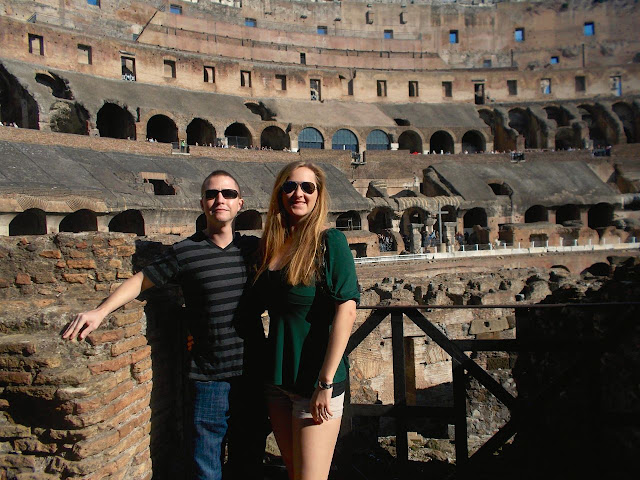 |
| David and I posing amidst the spans of the coliseum. |
The Coliseum was built to seat seventy-five thousand
spectators and it could be filled or emptied in fifteen minutes, using a gate
and seating section organization similar to how stadiums are organized today. Thousands of visitors can wander around the
Coliseum at once due to the large halls and other pathways built to accommodate
tens of thousands of Roman citizens.
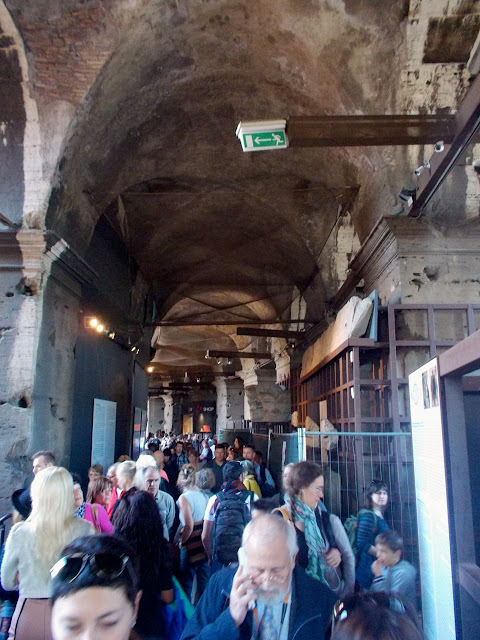 |
| Even today the halls of the coliseum still handle the crowds of thousands of visitors daily. |
The Colliseum is most famous for its gladiators (fun fact
gladiator also means sword and penis), but the Coliseum was also used to
recreated hunting scenes, execute criminals, and some texts claim it could be
flooded to recreated maritime battles.
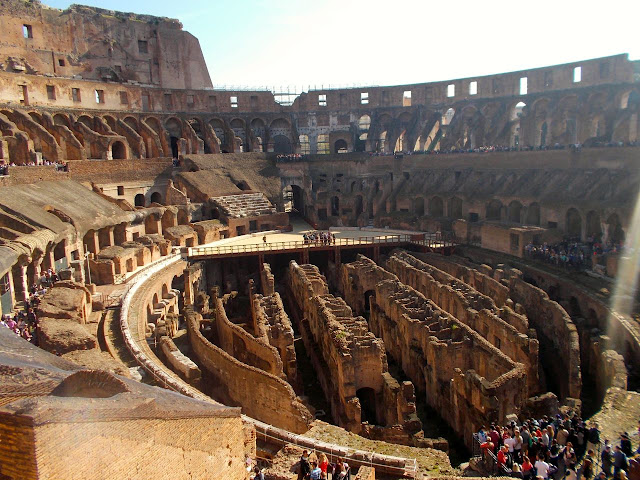 |
| The coliseum today. The floor is missing, but the remains of cells and cages below are now visible. |
The area on which the Coliseum stands was an artificial lake
built by the less than nice Emperor Nero.
A great fire consumed much of Rome during Nero’s reign and it is thought
he may have burned the city to make way for more bath houses and the lake for
his personal use. After Nero’s death the
next Ceasar, desperately wanting to improve public opinion of his title,
built the Coliseum as a gift to the people of Rome, for their enjoyment.
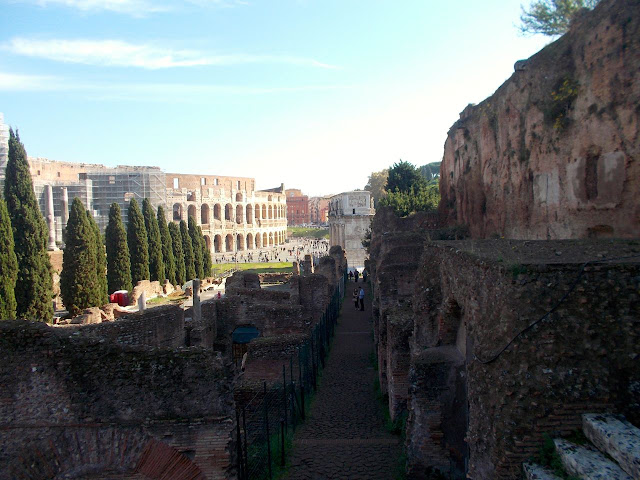 |
| This road was once flanked by shops on the Palentine Hill. The coliseum is off in the distance. |
Arches on the exterior of the structure were adorned with
statues of gods, goddesses, demi-gods, and heroes. These are gone today, along with the main
floor, and the retractable roof used to shade spectators on hot days. The movie Gladiator is really useful for
filling in these gaps.
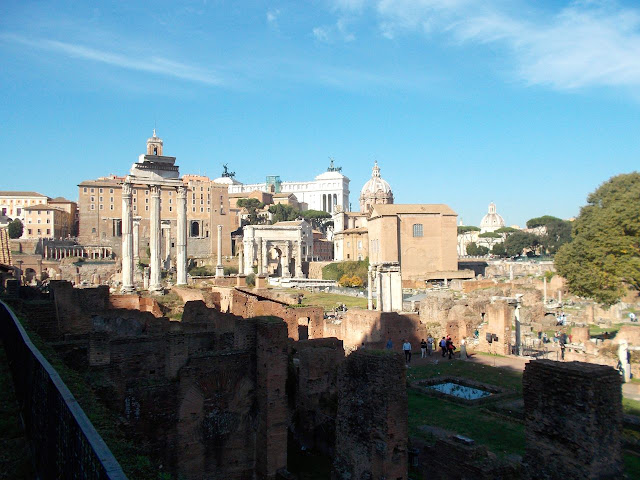 |
| What remains of the Roman Forum. This vast expanse of ruins can entertain visitors for hours. |
Our ticket to the Coliseum also included entrance to the
Roman Forum and Palantine Hill across the street. These two sites cover an immense area that we
spent over an hour and a half wandering through before finally finding an
exit. It’s one of the most extensive and
impressive ancient ruins I have ever visited, containing bath houses, residential
areas, government buildings, stores, royal palaces, streets and every other
kind of structure an ancient Roman would encounter on a daily basis. Multi-story buildings still stand almost
fully formed and functional. I hands
down loved the Roman Forum and Palentine Hill.
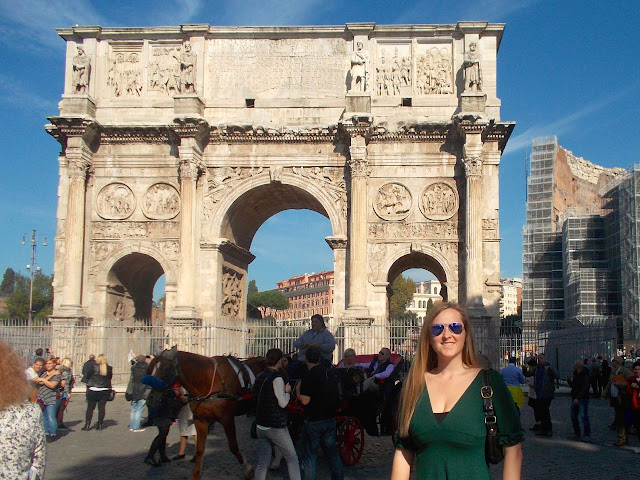 |
| Arches arches everywhere in Rome. |
We did some very non-Roman things in Rome as well. We saw the new James Bond film
Spectre. It was opening weekend, tickets were half the
price of what they usually are in the US, and much of the movie was filmed in
Rome. We wanted to see the sights we had
just visited on the big screen. We also
visited an American-style steak house which left me thoroughly
entertained. This restaurant seemed to
take every little thing American restaurants do differently and crammed them
into one experience. We got
complimentary chips and salsa and unshelled peanuts to snack on while waiting
for dinner. Guests could also buy a
bucket of miller, a US spring break favorite.
I did not see these things any where else in
Italy or Europe for that
matter.
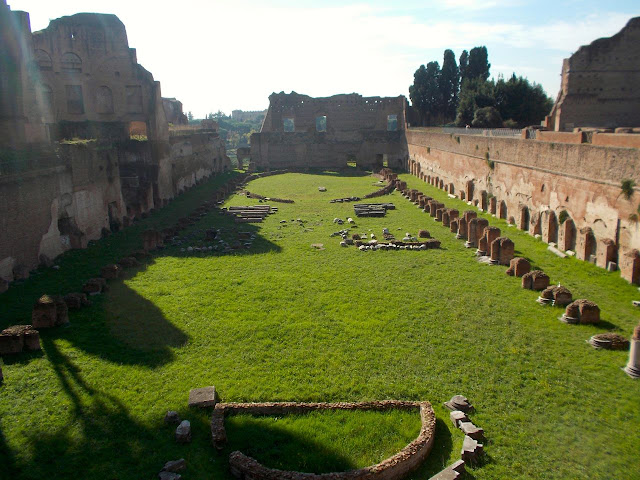 |
| Columns once flanked this expanse of the Palentine Hill. |
A few practical notes on our stay in Rome. We divided our time in Rome into three
days/sections of the city. We spent our
first day exploring the areas of the city not serviced easily by the
subway. It’s the center of the city
around the Pantheon. Our second day we
took the red line of the subway to
Vatican City, and the third day we took the
blue subway line to the Colliseum area.
Each ride on the subway only cost a euro and a half per person, making
it a very cheap way to get around.
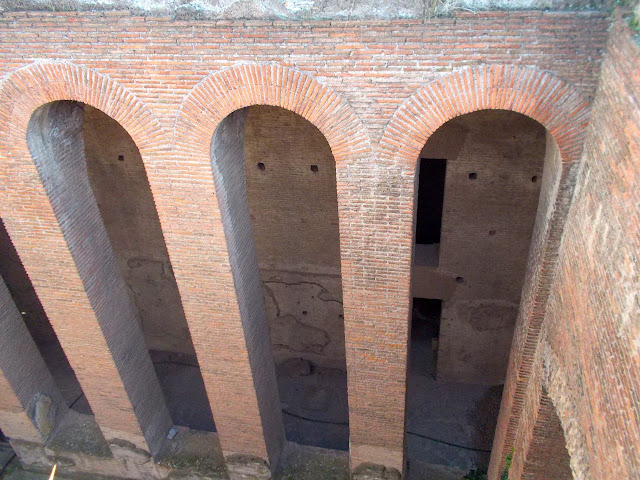 |
| Even today multistory buildings stand strong in the Roman Forum and Palentine Hill. |
We visited in November, which I expected to be cold, but
while it was chilly at night Rome was hot during the day. I even wore shorts to the Colliseum. We got to Rome via train and left via cruise
ship. The port of Rome (in a town called
Civitachia) is about a one hour train ride away. We took the train on a Sunday when it leaves
Rome about every hour (more departures every other day of the week). I think just about everyone on the train was
getting on the same cruise ship as us. Other than a little trouble finding a place for our luggage, it was an inexpensive (six euros) and easy journey.
 |
| Fountains and beautiful architecture are apparent everywhere in Rome. |
Now over a month later, I still think of Rome and get goose bumps. The Coliseum, one of the seven wonders of the modern world, and Roman Forum and Palentine Hill still leave me in awe just thinking about them. Rome really is a great place to visit, given the opportunity.



















No comments:
Post a Comment